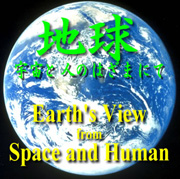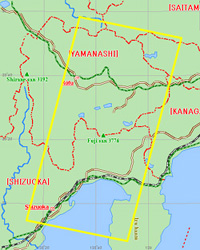
Mt. Fuji is 3,776m, the highest mountain in Japan. With its perfect conic shape, standing independently from other line of mountains, it deserves to be called the most beautiful mountain in Japan as sung in a song quite familiar to Japanese. To one's surprise, the beautiful conic shape was formed after repeated eruptions, and it is indeed an active volcano.
Figure -1 Bird's eye view image of Mt. Fuji (produced using ASTER/VNIR and DEM data observed on 4 Oct. 2002)
Enlargement (jpeg file 1.6MB)
Usually, satellite picture will be 2D because satellite takes image from overhead. However, to one's surprise, this picture, as if it is taken from an airplane during flight, is also produced from satellite image. Elevation of an object can be calculated using the variance between images taken from overhead (band 3N called vertical view) and backward (band 3B called backward view) with an accuracy of 10m (called Digital Elevation Model, DEM). The picture is made out of 2D picture by adding information of elevation to make it 3D.
Figure - 2 Image of Mt. Fuji (ASTER/VNIR observed on 4 Oct. 02)
Enlargement (jpeg file 1.8MB)
2D image before processing to 3D

Figure - 3 Location of the image on map
The first eruption of Mt. Fuji goes back to 100,000 years ago. Ever since, the mountain repeated eruptions many times with mountain slides for a few times before it formed the present stratovolcano appearance by about 10,000 years ago.
History of the mountain has been revealed by the study of lava and eruptions in peripheral area as well as through ancient manuscripts. Due to the recent study, Mt. Fuji was found to be in an early phase of its volcanic activity.
The most famous eruption was in 1707, when three craters were formed in southeastern mountainside (called Hoei crater taken by Japanese traditional era name at that time). Scale of the eruption and its vicinity to the capital Edo (present Tokyo) helped preserve lots of records of this eruption after 300 years to the present.
Although Mt. Fuji hasn't erupted since then, rush of low-frequency quakes occurred from October to December in 2000 and from April to May in 2001. Media picked up the quake and it triggered the fear of possible eruption anytime soon. With the stop of the quake, such fear seems to have been disappeared, "out of sight, out of mind".
In fact, specialists were optimistic about the eruption at that time. Because epicenter was not so deep underground and no crustal deformation was confirmed. Here is the detailed explanation:
Eruption occurs when magma is pushed up from deep underground to earth's surface. In the process, magma rises by breaking up rocks lying in between magma and earth surface.
As magma approaches to the surface, epicenter also moves up. At the same time, you will notice unusual upheaval on mountainside as magma breaks underground rocks and pushes up soil.
None of these symptoms of eruption were confirmed with Mt. Fuji at that time.
In every active volcano in Japan, earthquake recorders and angle meters are placed appropriately to allow for 24-hour monitoring to detect danger of eruption as early as possible. Although it is difficult to detect precise time, location and size of eruption, accuracy of such instruments have greatly improved.
Eruption is a natural phenomenon that cannot be prevented by human beings, no matter how well we are at prediction and observation. What matters most is how to respond to such natural phenomenon. As long as there is no damage to human or its properties by eruption or earthquake, it is called natural phenomenon, not disaster.
Disaster is a reflection of how well people prepared for it. In this sense, disaster prevention means to be better prepared to minimize the damages. Damages incurred where any measure of disaster prevention was not taken should be called man-made disaster. Recently, we don't hear much about huge damages caused by mountain eruption where monitoring is done properly.
Effective collaboration among researchers, government authorities, media and citizens is indispensable for disaster prevention. By the efforts of researchers in a long time, prediction of eruption based on observations has become quite accurate and authorities have greatly improved systematically on how to respond to the prediction.
It is now dependent on how to convey the information to citizens and how they take action, in other words, media needs to be equipped with knowledge about natural disaster and acknowledge the importance of disaster prevention to citizens.
In the end, it is up to individuals to make efforts to know the danger and remember how to take action in emergency. As long as we don't do anything when we are not faced with any possible danger of disaster, the collaboration mentioned above may not be functioning properly. It can be a turning point whether or not to make natural phenomenon, disaster.
Repeatedly, Mt. Fuji is a young active volcanic mountain. We are happy if you could remember the fact that it has been formed after repeated and on-going eruptions, whenever you see the grand figure.
1 Jan. 2003
Figure - 4 (a) Mt. Fuji
Mt. Fuji in early winter viewed from Otome pass (to southeast from Mt. Fuji) located at the border between Shizuoka and Kanagawa prefectures. It has a beautiful stratovolcano appearance standing independently from other line of mountains. Hoei crater is at the right hand of mountainside, black out part in white snow cover.
Figure - 4 (b) ropy lava
This lava is exhibited in volcano museum in Narusawa village, Tsuru county, Yamanashi prefecture. Its ropy lava is peculiar to low-viscosity lava.
Figure - 4 (c) specimen of Basalt
This is a cut and polished specimen of lava collected from Mt. Fuji. This lava is called Basalt, with lots of holes made after gas evaporation. White parts on the rock surface are large crystals of Plagioclase (called phenocryst).
Figure - 4 (d) Polarization-microscope picture of Basalt
This is a polarization-microscope picture of Basalt collected from Mt. Fuji (above: open nicol, down: crossed nicol). The rock is consisted of large crystals (phenocryst) and small groundmass (matrix). Phenocryst is consisted of feldspar (white and/or gray colored column crystal) and clinopyroxene (crystal with mesh cracks or bright color). The groundmass is consisted of small feldspar, clinopyroxene, glasses and so on.
Copyright and ownership of figure - 1 and 2 belong to JSS and figure - 4 and the text belong to Sapporo Gakuin University professor Yoshiyuki Koide. Permission from JSS is required of their use for other purposes.